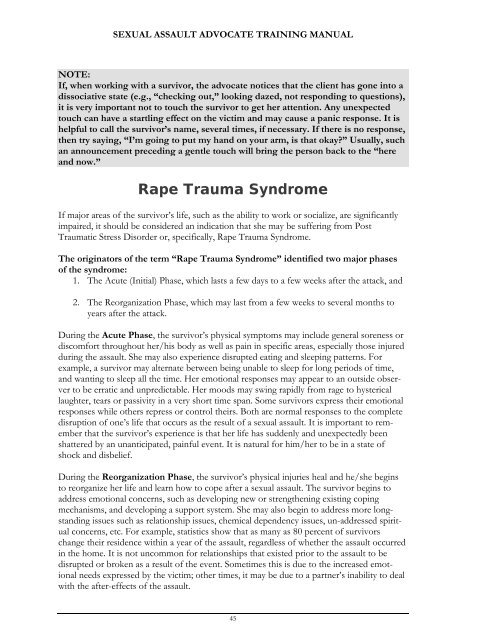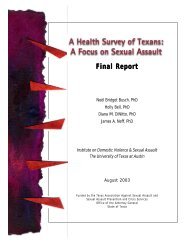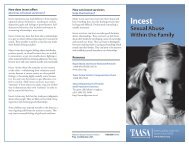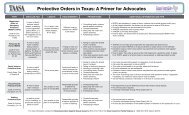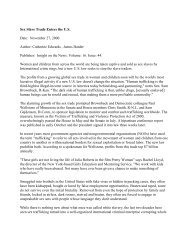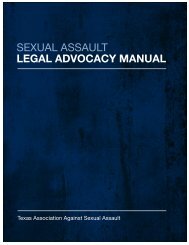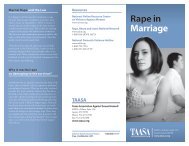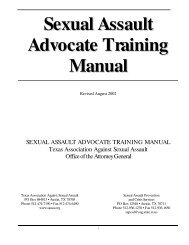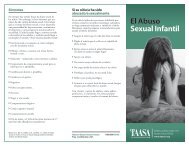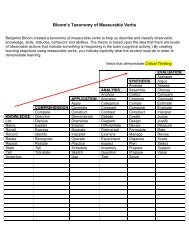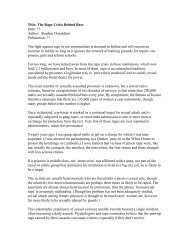Sexual Assault Advocate Training Manual - Texas Association ...
Sexual Assault Advocate Training Manual - Texas Association ...
Sexual Assault Advocate Training Manual - Texas Association ...
You also want an ePaper? Increase the reach of your titles
YUMPU automatically turns print PDFs into web optimized ePapers that Google loves.
SEXUAL ASSAULT ADVOCATE TRAINING MANUAL<br />
NOTE:<br />
If, when working with a survivor, the advocate notices that the client has gone into a<br />
dissociative state (e.g., “checking out,” looking dazed, not responding to questions),<br />
it is very important not to touch the survivor to get her attention. Any unexpected<br />
touch can have a startling effect on the victim and may cause a panic response. It is<br />
helpful to call the survivor’s name, several times, if necessary. If there is no response,<br />
then try saying, “I’m going to put my hand on your arm, is that okay?” Usually, such<br />
an announcement preceding a gentle touch will bring the person back to the “here<br />
and now.”<br />
Rape Trauma Syndrome<br />
If major areas of the survivor’s life, such as the ability to work or socialize, are significantly<br />
impaired, it should be considered an indication that she may be suffering from Post<br />
Traumatic Stress Disorder or, specifically, Rape Trauma Syndrome.<br />
The originators of the term “Rape Trauma Syndrome” identified two major phases<br />
of the syndrome:<br />
1. The Acute (Initial) Phase, which lasts a few days to a few weeks after the attack, and<br />
2. The Reorganization Phase, which may last from a few weeks to several months to<br />
years after the attack.<br />
During the Acute Phase, the survivor’s physical symptoms may include general soreness or<br />
discomfort throughout her/his body as well as pain in specific areas, especially those injured<br />
during the assault. She may also experience disrupted eating and sleeping patterns. For<br />
example, a survivor may alternate between being unable to sleep for long periods of time,<br />
and wanting to sleep all the time. Her emotional responses may appear to an outside observer<br />
to be erratic and unpredictable. Her moods may swing rapidly from rage to hysterical<br />
laughter, tears or passivity in a very short time span. Some survivors express their emotional<br />
responses while others repress or control theirs. Both are normal responses to the complete<br />
disruption of one’s life that occurs as the result of a sexual assault. It is important to remember<br />
that the survivor’s experience is that her life has suddenly and unexpectedly been<br />
shattered by an unanticipated, painful event. It is natural for him/her to be in a state of<br />
shock and disbelief.<br />
During the Reorganization Phase, the survivor’s physical injuries heal and he/she begins<br />
to reorganize her life and learn how to cope after a sexual assault. The survivor begins to<br />
address emotional concerns, such as developing new or strengthening existing coping<br />
mechanisms, and developing a support system. She may also begin to address more longstanding<br />
issues such as relationship issues, chemical dependency issues, un-addressed spiritual<br />
concerns, etc. For example, statistics show that as many as 80 percent of survivors<br />
change their residence within a year of the assault, regardless of whether the assault occurred<br />
in the home. It is not uncommon for relationships that existed prior to the assault to be<br />
disrupted or broken as a result of the event. Sometimes this is due to the increased emotional<br />
needs expressed by the victim; other times, it may be due to a partner’s inability to deal<br />
with the after-effects of the assault.<br />
45


